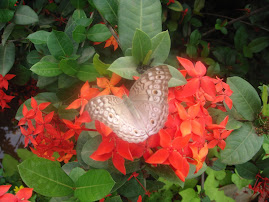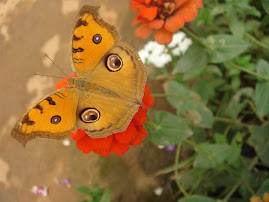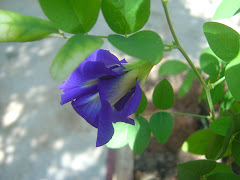
Last year, on an impulse, I picked up a clump of
water hyacinth on our way back home from a picnic.
I'd never really looked at the blooms from close
quarters before. But ever since blooms appeared on
the clump--well, I can't get enough of them!
It's easy to understand why plant collectors in the
19th century started using them as ornamental pond
plants. These delicate blooms last for a day and
they do hold your attention! As you can see from
the picture that they have a beautiful pattern and
the topmost petals have a yellow spot.

A native of the Amazon Basin, its botanical name
is Eichhornia crassipes. Ever since these seemingly
innocuous plants were used as pond ornamentals,
they spread rapidly in places like Africa and Southern
USA. In all the tropical and sub-tropical regions
of the world, it is considered to be one of the
worst weeds! It proliferates across lakes and rivers,
ditches and backwaters. It has choked rivers and lakes
in Asia and Africa. In India, the problem is no less.

The birth of the "Blue Devil"--another name that the
plant is known by.


With inflated petioles and a mass of hair-like roots,
the water hyacinth forms a dense mat on the surface,
doubling the area every two to three months. New
daughter plants are formed on floating stolons which
grow from the mother plants. The leaves block out the
sun smothering the life below. Any kind of water activity
such as fishing or boating becomes impossible. Its high
demand for oxygen deprives all other marine life of the
gas and this leads to depletion of fish stocks.
I checked a few sites and it's interesting to know how
different countries are handling this aquatic menace.
The introduction of one of its natural enemies, a root-
eating beetle should help, to some extent.

I have mine in an earthen container where it certainly won't
be allowed to run riot! Thoughts of "Weed!" do come to mind
but it's good to enjoy the blooms--even if they belong to
the plant that is abhorred in so many countries around the
world!













































.jpg)
































17 comments:
Kanak I used to grow these and quickly got rid of them. They have been used in Japan to treat waste water...they remove toxins in the water. They are also used in Thailand in the furniture industry...lovely rush looking chairs and sofas. They also make great compost material. Anyone tried eating the leaves or flowers?
It looks like butterflies. It is such a shame that some of the prettiest flowers can be such menaces.
Hi Kanak, This is so interesting to me. I was not familiar with this plant. I was fascinated with its beauty and then dismayed by the problems it causes. Thanks for another interesting post.
It's beautiful! Such a shame it's so invasive...
Katarina
This plant is a real double edged sword, isn't it? I don't have the plant for the reasons already mentioned, but I must admit that it can be a very pretty plant.
Kanak, did I ever ask you about the Moringa tree? Do you have one?
How could such a beautiful flower be such a pain in the you know what! Awww, it's just gorgeous!! I think you're smart to be growing it in a container.
At least you can still enjoy the blooms while not worrying about it taking over anything other than the container!
I can see why you like it so much Kanak. It is a beauty.
Those mass hair roots really gives problem. I know. I recalled long time ago we have them on big aquarium and it turned out to be a bad idea to have them. Nonetheless, the blooms are beautiful. That is why people are still growing them as ornamental plant.
Helen, i've read about what you've written but eating the leaves and flowers...? No. If they threaten to spill out of the container, they'll quickly be composted!!
Tina, Mildred, Katarina, pity isn't it?
Prospero, it's the first time you've asked me about the Moringa tree. I had one some 10 years ago but the yearly flooding made sure it died! And I don't have the heart to plant it again.
It's abundant in our region--we have the tender and mature seedpods/leaves/flowers.
Wendy/Susie/Stephanie, I can't stop taking pictures when they put on a show like that!
Like Tina I find it sad that some of the most beautiful blooms are attached to invasive plants. :) Enjoy your pretties in their container water garden.
Hi Kanak, it is a beautiful flower! It's really hard to believe it has such negative qualities:-( Those matted roots look 'strangling'. Nature is full of contradictions and surprises;-) Jan
Mine were given to me, I don't remember it having this coloring though. These are BAD plants in my area, but not illegal (yet). I think mine in my (metal) pond died though. Looks like the lilies survied, so that makes it all ok:)
Such a beautiful enemy:) (Enjoy:)
Blue devil seems to really sum it up! Crazy how something so delicate and lovely-looking can be such a menace. We don't help the world much sometimes when we just have to have some plant that doesn't belong, then it gets out of control. So many species have escaped cultivation and become pests. Sorry not to have been here much lately, I am very short of time for blog-related stuff lately!
Racquel, I'll do just that. Thanks.
Jan, the roots tell you how BAD the plant can be. The blooms remind me of orchids too!
Carla, 'beautiful enemy'---so very true!! If they spill over, 'compost' is the only word I'll associate with them!
Karen, it doesn't matter...though I love your visits. I haven't been able to access Wordpress blogs easily. Which is why I couldn't visit you too. Thanks for stopping by.
SBA, thank you so much for visiting...and for your kind words.
Beautiful pictures as always Kanak! Yes, the water hyacinth is an interesting plant! We have an area on the farm where we grow them in canals: for their beauty; their ability to multiple so rapidly and for their incredible benefit as a quick rotting and highly nutritious compost. We got the idea from Mexico. The Mayans cultivated a large swamp outside modern Mexico City, they made wide channels and grew hyacinth in those channels and once a year harvested the hyacinth and spread it on the adjacent land. Very quickly that once swamp became highly productive farmland - enough to feed a city of over 200,000 people. The technique is called Chinampas.
So don't be afraid of that blue Devil! Harvest and compost regularly, she will be happy to provide a constant stream of beautiful flowers to serve your eye, and your garden!
Hi Ancel, so lovely to hear from you! although I did read up on the W.hyacinth, I did not come across the process called Chinampas. But I've read about composting, of course. Thanks for telling me... I'll surely do that . How I wish countries like mine would take composting water hyacinth seriously.
Well, I am glad I made it here when I did. My husband has some of those in his whiskey barrel water garden. One is blooming today, and I kept forgetting to take its picture until I read where you said the bloom only lasts one day. It does have more coming on, but I'm glad I made it out there to take the first one, with the buds in the background.
If they get too thick, I'll put some on the compost pile.
Post a Comment